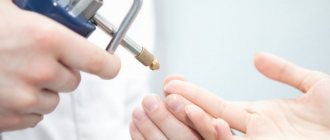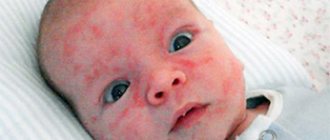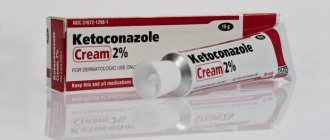Any deviations in the child’s well-being cause anxiety in parents and force them to immediately take action. But some disturbances in the functioning of the body may practically not manifest themselves at all, especially in the early stages, and subsequently lead to unwanted complications. One of these insidious diseases is anemia, which is indicated by low hemoglobin.
What is hemoglobin and its role in the children's body
Hemoglobin is a complex protein containing a divalent iron atom. It is found in red blood cells (erythrocytes), which are shaped like a biconcave disc. Iron itself, in addition to hemoglobin, is present in myoglobin, which is deposited in muscle cells. At the same time, in children the level of hemoglobin is higher, and the amount of myoglobin is lower than in adults. As you grow older, its level gradually approaches adult levels.
In infants up to 4-6 months, there is additional fetal hemoglobin HbF, which gradually gives way to the usual form of HbA.
The main function of hemoglobin is to carry out gas exchange. Due to the iron atom, it is able to bind oxygen entering the blood from the lungs, forming the so-called oxyhemoglobin. Together with the blood flow, it spreads throughout the body, delivering oxygen to all tissues and organs. By giving it away, in return it attaches molecules of carbon dioxide, transforming into carbohemoglobin. Then, again entering the lungs with the bloodstream, it gives it away, making room for oxygen. Thus, hemoglobin plays a very direct role in cellular respiration, supporting the vital activity and normal functioning of all cells of the human body.
Hemoglobin is able to bind with carbon monoxide, turning into carboxyhemoglobin, as well as with other toxic substances. This negatively affects the functioning of the body, since the cells do not receive enough oxygen, and can cause death.
In addition, it is involved in cell division, the correct course of a number of redox processes, as well as DNA synthesis. Therefore, a decrease in hemoglobin, especially for children, poses a serious danger and can lead to very undesirable consequences. In such cases, anemia is diagnosed. Depending on the level of hemoglobin, there are 3 degrees:
- light;
- average;
- heavy.
But since children of different ages have their own norms for hemoglobin content in the blood, we can only talk about the presence of anemia when comparing actual indicators with normal ones.
Nutrition rules for children
First of all, it is necessary to point out that hemoglobin deficiency is often associated not with a lack of certain micronutrients, but with chronic diseases of the gastrointestinal tract, hormonal, and cardiovascular systems.
Therefore, you should definitely consult your children’s doctor (pediatrician) about this. He will also direct you to all the necessary studies and tests that will help establish the exact cause of anemia.
Up to 1 year
To increase the level of hemoglobin in the blood of children under one year old, breast milk is the optimal diet. And it is more important during this period to follow a healthy diet for the young mother , including iron-containing foods in the diet, as well as those rich in B-group vitamins. These include:
- beef;
- lean pork;
- liver (beef or pork);
- apples;
- grenades;
- carrot;
- nuts;
- seafood;
- legumes;
- cereal porridge
And the most important thing is to eat a varied diet. That is, regularly prepare different dishes to normalize the biochemical composition of blood and breast milk.
If the child is bottle-fed (formula), then preference should be given to those that contain iron and B-group vitamins . You should consult your pediatrician about this. Formulas are always selected individually, depending on how well the child’s body assimilates them.
If the child is more than 9 months old, then complementary feeding is allowed. In this case, be sure to add ground grain porridge, meat puree, vegetable oil, natural compotes or juices to the diet (must be diluted with water).
From 1 to 3 years
During this period, preference should be given to vegetables, fruits, herbs, and meat purees. If you have low hemoglobin, you should not overuse dairy products, especially cottage cheese, yogurt, dairy desserts, kefir - they contain calcium, which makes it difficult to absorb iron.
Also, the diet must include applesauce (or dried apples), carrot juice or puree (with sugar), buckwheat porridge, and legumes (not earlier than 18 months). You should also give up wheat bread in favor of bran bread - this is a good prevention of constipation (and at the same time, bran has a high iron content, almost 20 mg per 100 grams).
And, if possible, the child should be breastfed up to 2–3 years of age . Mother's milk is a concentrated mixture of vitamins, easily digestible proteins, iron, which best helps increase hemoglobin, as well as comprehensively strengthen the immune system.
From 3 to 6 years
In addition to recommendations for children under 3 years of age (with the exception of breast milk), it is recommended to gradually add to the diet:
- chocolate (and other cocoa-based products, with the exception of white chocolate, as it has a high milk content);
- liver (can be in the form of puree or pate with vegetables, it is recommended to cook at home);
- berries;
- fruit juices;
- prunes, raisins, dried apricots;
- eggs (chicken eggs are also suitable, but quail eggs are much healthier and easier for the stomach to digest);
- pumpkin, potatoes (boiled or baked, without frying).
You can also give small amounts of table flaxseed oil - it is rich in omega-3 unsaturated fatty acids, which accelerate intercellular metabolic processes, including those involving iron molecules.
Not recommended foods at this age include fatty cheeses, sour cream, fermented baked milk, as well as various types of desserts.
From 6 to 12 years
At this age, you can quickly increase hemoglobin using the following foods and drinks:
- greens (including parsley, turmeric, basil);
- pomegranate juice (not recommended in concentrated form, must be diluted);
- fresh and baked apples;
- nuts;
- wheat or rice bran;
- seafood (preference should be given to fatty fish, as well as red and black caviar).
Also, many pediatricians recommend making tea at this age based on rose hips - this helps not only raise hemoglobin, but also strengthen the immune system.
But non-recommended foods at this age include soda in any form, dairy yoghurts, fried potatoes, and fast food - it’s best to avoid all of this .
You should also definitely avoid black tea, coffee and any other drinks that contain caffeine - they all significantly slow down the absorption of iron and increase the concentration of tannins in the blood (which interfere with biochemical reactions with amino acids).
Reasons for decreased hemoglobin levels in children
There are 4 main reasons for low hemoglobin levels in children. This:
- iron deficiency in the body, which may be a consequence of insufficient intake from food, impaired absorption in the intestine or transport from the blood by a special compound transferrin;
- increased need for iron, which is typical during periods of intense growth, as well as menstruation in teenage girls;
- slowdown in red blood cell production as a result of the development of pathological changes;
- heavy blood loss as a result of injury, surgery or internal bleeding.
But the decrease in hemoglobin concentration in the blood does not occur immediately, but gradually. Especially if the reason for this lies in a lack of iron. This is explained by the fact that the body has specific depots of iron, which is stored, in addition to myoglobin, in the form of ferritin and hemosiderin. As part of these compounds, iron, which is used by the red bone marrow in the synthesis of young red blood cells and their constituent hemoglobin, is stored in the lungs, liver, and spleen. Also, a small amount of iron is deposited in the intestinal mucosa. Therefore, a decrease in hemoglobin levels occurs with prolonged iron deficiency, when the child’s body has already used up all its reserves.
There are many reasons that can cause a decrease in hemoglobin levels in children. But in each case, the situation requires the earliest possible intervention and correction.
Infants
The main causes of anemia in children under 1 year of age are disorders of intrauterine development and later nutrition. Most often, premature babies born with low birth weight or from multiple pregnancies suffer from a decrease in hemoglobin. Also contributes to this:
- iron deficiency in the body of a pregnant or lactating woman;
- maintaining breastfeeding as the only food source after 6 months;
- irrational complementary feeding;
- the presence of celiac disease (a hereditary disease in which there is intolerance to gluten contained in most types of cereals);
- functional digestive disorders, in particular frequent excessive regurgitation.
Children of preschool and primary school age
In this age category, the main reasons for decreased hemoglobin are:
- unbalanced diet;
- helminthiasis (helminthic infestation);
- active growth;
- the development of gastrointestinal diseases that interfere with the normal absorption of iron in the intestines;
- injuries and surgical interventions accompanied by heavy blood loss;
- severe nosebleeds.
Teenagers
In adolescents, iron requirements increase naturally due to the onset of a period of active growth and hormonal changes. Therefore, errors in nutrition, especially a tendency to diets for weight loss or vegetarianism, often become the cause of the development of anemia. In addition, children of this age are often diagnosed with gastrointestinal diseases, which negatively affect the quality of absorption of this macronutrient.
Also, the cause of low hemoglobin in adolescents can be:
- heavy menstrual bleeding;
- helminthic infestations;
- injuries, operations.
Other reasons
There are also a number of diseases that can occur in children of any age and are manifested by a decrease in hemoglobin. This:
- blood diseases;
- kidney pathologies;
- tuberculosis;
- systemic vasculitis;
- Crohn's disease;
- allergy;
- malignant neoplasms;
- chronic inflammatory processes.
How to increase hemoglobin in a breastfed baby
Every effort must be made to establish breastfeeding, and for the first months (or even years) of the baby’s life, breastfeed. This will be the best prevention of anemia in a child. Immediately after birth, you need to put the baby to the breast, then colostrum, once in the baby’s intestines, will start the normal functioning of the gastrointestinal tract. Thus, the intestinal cells will learn to absorb all the necessary substances from food, including iron. If you breastfeed your baby, he will get everything he needs from your milk. According to one version, the mother’s nutrition does not even matter for the composition of human milk. In any case, iron will be secreted in the volume required by the child and will be almost completely absorbed from the digestive tract.
Nevertheless, the mother needs to monitor her diet, at least in order to replenish the supply of substances necessary for her health. To maintain normal hemoglobin levels, it is necessary to consume foods containing iron in sufficient quantities. And it is not at all necessary that these are products of animal origin.
Here are the top foods that are leaders in iron content:
- Turmeric, spirulina.
- Green sprouted buckwheat.
- Pomegranate and beets.
- Green apples.
- Sea kale.
- Pumpkin seeds, flax.
- Dried apricots.
- Spinach.
- Walnuts.
- Rose hip.
- Lentils and beans
It is important to know that there are rules for taking iron:
— vitamin C helps its absorption (you can, for example, cook lentils with broccoli or add lemon);
- calcium complicates the absorption of iron, as it slows down its absorption;
- Tea and coffee are also not advisable if you want to maintain healthy hemoglobin levels, as they flush iron from the body.
Symptoms of low hemoglobin
Manifestations of anemia increase as hemoglobin levels decrease. Therefore, with a mild form, children and their relatives may not notice obvious manifestations of illness, but gradually the symptoms will intensify. Typical manifestations of low hemoglobin are:
- increased weakness and fatigue;
- drowsiness;
- pallor of the skin and mucous membranes, subsequently cyanosis of the nasolabial triangle may be observed;
- peeling, dry skin;
- shortness of breath that occurs after physical exertion, and in more severe situations, at rest;
- feeling of increased, irregular heartbeat;
- dizziness that can lead to loss of consciousness;
- noise in ears;
- headache;
- increased irritability, tearfulness;
- formation of cracks in the corners of the mouth;
- deterioration of hair and nails with the appearance of white spots;
- menstrual irregularities.
A characteristic sign of low hemoglobin is the desire to eat inedible foods, for example, chalk, clay, minced meat, raw dough, or to smell the strong odors of gasoline, acetone, etc. But this does not happen immediately, but with long-term low hemoglobin.
What hemoglobin is considered low
| Newborn babies | less than 140 g.l. |
| 1 month | less than 110 g.l. |
| 3 months | less than 90 g.l. |
| 6 months | less than 110 g.l. |
| year | less than 100 g.l. |
If an infant's hemoglobin is slightly reduced, it can be brought back to normal by changing the mother's diet and lifestyle. But if the indicators are much lower than normal, for example, immediately after birth, the number of red blood cells in the blood does not exceed 130 g.l. or at 9-10 months below 100 gl, it is necessary to urgently identify the cause of low hemoglobin and prescribe treatment.
Possible consequences
Anemia should not be perceived as a harmless condition that will go away on its own, especially if it occurs in a child. Indeed, with a reduced amount of hemoglobin, the quality of cellular respiration decreases. As a result, all organs and the brain in particular constantly experience a lack of oxygen.
Therefore, in addition to deterioration of the child’s general condition, this can lead to:
- delayed intellectual development;
- decreased immunity, which will be manifested by an increased incidence of acute respiratory infections and other infectious diseases;
- decreased memory, attention and other disorders of the nervous system;
- diseases of the cardiovascular system.
The most severe complication of low hemoglobin in children is hypoxic coma. Today this is rare, but not impossible.
What foods can increase hemoglobin in the blood?
Found in animal foods. Its absorption reaches 30%. The absorption of this microelement is not affected in any way by other components of our diet.
It can be found in vegetables and fruits. The absorption of this species is influenced by many factors, both external and internal. This includes taking certain medications and antagonist products that convert an important substance into insoluble salts that are excreted from the body naturally.
It is often said that vegetarians are at risk of developing anemia. This misconception is due to the lack of meat containing heme iron in their diet. However, vegetarians who correctly plan their daily menu and include plant foods rich in beneficial microelements do not face the problem of anemia.
Products that raise hemoglobin in the blood are varied. These are not only fruits, vegetables, poultry, fish, nuts, but also herbs and seasonings. Next, we will give a complete list and table so that you know what the diet for anemia should consist of.
Anemia in a breastfed baby is not a cause for alarm. Usually this phenomenon does not require drug treatment and goes away if one requirement is met - the mother’s menu must include meat and offal, as well as vegetables and fruits (pomegranate, apples, bell peppers, tomatoes).
But what to do if the child is put on artificial nutrition and cannot receive nutrients from mother’s milk, like a baby? Then the task becomes more complicated:
- A special mixture with a high iron content is selected for the baby.
- If the time has come to introduce complementary foods, it is better to start with vegetables that increase hemoglobin in the blood - beets, Brussels sprouts.
- The first porridge should be buckwheat - this will help relieve the growing body from oxygen starvation.
- Don't forget about meat on the menu - it could be beef, chicken breast, turkey, rabbit.
- It is useful to give your baby a decoction of rose hips, as well as compotes based on dried apricots, prunes and other dried fruits.
- Not only the correct diet is important, but also the correct daily routine, which necessarily includes walks in the fresh air - at least 4-6 hours daily.
- Meat, fish, and buckwheat dishes are effective.
- Legumes are another indispensable component on the menu.
- The combination of iron and vitamin C is ideal, so don’t forget to give your child lemons, oranges, currants, and kiwi.
- A decoction of rose hips is a recipe that we have already talked about, but it is so effective that we are ready to repeat it again - be sure to use this useful folk remedy for anemia. Pour boiling water over the dried berries and leave them in a thermos for a couple of hours. The resulting drink can be sweetened a little and drunk twice a day. Afterwards, you need to rinse your mouth - ascorbic acid contained in fruits destroys tooth enamel.
The list of foods that increase hemoglobin in children is no different from what is presented above for adults. The main thing is to consult a doctor, because your child may be allergic to some fruits, and some simply are not suitable for him due to his age.
We advise you not to panic if your baby develops symptoms of anemia. In most cases, the problem can be easily eliminated with the help of a diet prepared by a specialist. And consuming products based on natural substitutes will help you fall in love, for example, with healthy and iron-rich buckwheat - it is found in crispy bread made from amaranth flour, which is so pleasant to eat during a snack.
We have already found out which foods contain iron for hemoglobin and how we can increase this indicator. It remains to talk about the most popular recipes for combating anemia.
What to do with low hemoglobin in children
First of all, if signs of low hemoglobin occur, you should take a general blood test. On its basis, the hemoglobin level is determined, and a number of other indicators that are important for diagnosing anemia are determined. If you receive hemoglobin levels twice below the age norm, you should contact a pediatrician or hematologist. The doctor’s task is to establish the cause of anemia and select treatment that will simultaneously be aimed at increasing hemoglobin levels and eliminating the cause of its decrease.
For this purpose, the doctor collects anamnesis, finds out the nature of existing or previously suffered diseases, injuries, etc. A biochemical blood test and a general urine test are also required. Depending on the indications, to establish the cause of a decrease in hemoglobin in children, the following is carried out:
- Ultrasound of the kidneys and pelvic organs;
- fibrogastroduodenoscopy;
- colonoscopy;
- stool test for the presence of occult blood.
Based on the results of the examination, the doctor makes a diagnosis and prescribes treatment for the disease or disorder that provoked a decrease in hemoglobin concentration. It is also mandatory to prescribe nutritional correction and take iron-containing medications for oral use. Only in exceptional cases, for health reasons, children can be prescribed parenteral administration of iron or red blood cells to increase hemoglobin.
It is recommended to walk as much as possible in the fresh air, since physical activity and free access to oxygen activates hematopoietic processes.
Nutrition correction
All children who experience a decrease in hemoglobin, in the absence of food allergies, are recommended to include in their daily diet:
- veal, beef, white chicken;
- liver and beef tongue;
- broccoli, spinach, parsley, watercress;
- pumpkin, tomatoes;
- cabbage, new potatoes, onions, beets;
- fruits, berries;
- buckwheat, rice;
- legumes
Daily use of Hematogen in an age-appropriate dosage will help maintain sufficient iron intake from food.
How to increase hemoglobin in a child using medications and how to increase it in the blood with them
In order to increase a child’s hemoglobin with medications, they must quickly increase its level in the blood, be safe and palatable, for this purpose the following active ingredients are used:
- ferrous sulfate: Actiferrin, Tardiferon, Hemofer prolongatum, Ferroplex;
- iron hydroxide: Maltofer, Ferrum Lek;
- Ferrous gluconate: Totema;
- Ferrous fumarate: Ferronal.
For intestinal diseases or a severe drop in hemoglobin, intravenous forms are used: Ferrum Lek, Venofer. For 1 kg of weight per day, a child under 3 years old needs 3 ml, the daily dosage for 3-7 years old is 45-60 mg, from 7 years old and for adolescents - 100-120 mg.
Syrup
In syrup form, Ferrum Lek and Aktiferrin are recommended for children. The first preparation in 1 ml contains 10 mg of iron. It is taken during or immediately after meals in 1 or 2 doses. The syrup can be mixed with fruit and vegetable juices and added to baby food. Up to a year, 2.5-5 ml is prescribed, and from a year, 5-10 ml.
Aktiferrin syrup in 1 ml contains 6.8 mg of iron, recommended from 2 years. For preschoolers, the dose is 5 ml, it is prescribed 1 or 2 times a day, and for schoolchildren the frequency increases to 3 times.
Iron supplements in tablets
Iron-containing tablets are prescribed from the age of 7; per day for children and adolescents the following is prescribed:
- one tablet 100 mg Ferrum lek (chewable) or Maltofer 100 mg;
- one tablet of Tardiferon 80 mg;
- Actiferrin in capsules (34.5 mg) 1-2 pieces from 7 to 11 years and 2-3 pieces from 11 years.
Drops
Preparations with iron in drops are most often used for newborns and young children, for example, Actiferrin is prescribed at the rate of 5 drops per 1 kg of weight. Take the medication 2-3 times a day. From one to 3 years of age, the dose increases to 25 drops 3 times a day; schoolchildren are recommended 50 drops three times a day.
Maltofer contains 2.5 mg of iron in 1 drop; it is used to reduce hemoglobin even for premature babies in a daily dosage of 1-2 drops. Before one year of age, 10 drops are prescribed, from 5 years, 20 drops, after 11 years, 40 drops.
Vitamins
Vitamins with iron for children have advantages over single-component products; they contain minerals and vitamin components necessary for the synthesis of hemoglobin. A low dose of iron is considered a disadvantage, so they are used only for prophylactic purposes after normalization of blood composition. The following means are used:
- Vitrum Kids,
- Alphabet Schoolboy,
- Vitamins Immuno Kids,
- Multi-tabs Junior.
How long to take the drugs
Hemoglobin does not increase immediately when taking iron supplements. At first, the child’s health returns to normal, then by the end of the second week, immature red blood cells—reticulocytes—appear in the blood. After 1.5 months of use, a repeat analysis can be carried out, since the indicator begins to increase only at the end of 3-4 weeks.
In order to create the necessary supply of iron in the body, it will take from 3 to 6 months. After a normal blood composition is detected, the medications are taken in half the dose. If you do not complete the full course, then the hemoglobin drops again quite quickly.
Solving the problem through proper nutrition
Eating the right foods rich in iron will help you get rid of iron deficiency anemia.
Animal origin:
- Meat.
- Fish.
- Cream.
- Oil.
- By-products - liver, heart, tongue, kidneys.
Plant origin:
- Cereals - buckwheat, legumes.
- Vegetables - tomatoes, beets, potatoes, herbs, carrots, bell peppers.
- Fruits - pomegranate, pear, currant, apple, plums, apricots, quince, persimmon.
- Berries - currants, blueberries, wild strawberries, strawberries.
- Mushrooms.
Beverages:
- Plum juice.
- Tea with honey and lemon.
- Grape-apple juice.
- Tomato juice.
- Carrot juice.
- Beetroot juice.
Iron content in products (per 100 g):
- 72 mg – Beans
- 51 mg – Hazelnuts
- 45 mg – Oatmeal
- 37 mg – Skim milk cheese
- 31 mg – Buckwheat
- 29.7 mg – Pork liver
- 20 mg – Peas
- 19 mg – Brewer's yeast
- 16 mg – Sea kale
- 15 mg – Apples (dried fruit)
- 12 mg – Dried apricots
- 9 mg – Blueberry
- 9 mg – Beef liver
- 6.3 mg – Heart
- 5 mg – Beef tongue
Read
As you know, the main cause of iron deficiency in the body is an improper diet. Therefore, it is with the help of its establishment that it is worth fighting the problem. Of course, there is no need to feed a newborn with meat and force him to drink pomegranate juice. But it’s worth making some adjustments to the menu. This should be done taking into account the age of the child.
- Breastfed babies up to 6 months can get iron from breast milk. Therefore, mother should enrich her own menu with this microelement.
- If the baby is artificial, then parents should give preference to formulas enriched with iron.
- You need to start complementary feeding with vegetables and cereals with a high iron content (buckwheat, Brussels sprouts and spinach).
- By 8 months you can begin introducing meat (chicken, beef).
- If the baby tolerates teas well, you can offer a rosehip decoction.
Everyone knows that there are certain foods that increase hemoglobin in children. But almost all of them must be used correctly. For example, animal foods that contain high amounts of iron (beef, turkey, chicken, organ meats and cheeses) should be consumed along with vitamin C and minerals.
Without them, iron simply will not be absorbed by the body in the required volume, but will accumulate in the liver up to a certain point, which will slow down the increase in hemoglobin. The only product that combines all the necessary components to increase hemoglobin is pomegranate. Therefore, you can drink it yourself or give it to your baby.
Therefore, nutritionists recommend instilling in your child a love of foods such as meat, fish, eggs, leafy greens, bread, fruits and vegetables from a very early age. All this is required by the growing body and should be present on the menu of a one-year-old baby. But parents’ newfangled passion for vegetarianism should be eradicated in the bud! Such diets will not only not make the child healthier, but will also cause an irreparable imprint on the normal functioning of the baby in the future.
In more severe cases, when hemoglobin is greatly reduced or does not increase, the doctor may prescribe iron-based medications.











